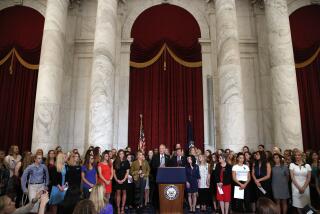Most Claims Over Radiation Testing Settled, Pena Says
- Share via
WASHINGTON — The Clinton administration announced Friday that it has settled all but two claims made by families of civilians subjected to involuntary radiation experiments and is close to resolving other claims brought by victims of the Cold War-era research.
The federal government has paid a total of $6.5 million to 16 of the 18 people who were injected with uranium or plutonium without their knowledge as part of secret research conducted by the Defense Department and the Atomic Energy Commission after World War II.
In addition, the administration said it is pursuing settlements with a second group of research subjects who were aware of the tests but were not adequately warned about potential risks. Those people must demonstrate that they were harmed by the experiments before they can receive compensation.
The settlements are part of a larger effort by the Clinton administration to comply with guidelines established by an advisory committee that investigated several thousand human radiation experiments conducted between 1944 and 1974.
“Today’s announced actions are designed to increase public trust, to ensure public accountability and demonstrate this administration’s continuing commitment to openness in government,” said Energy Secretary Federico Pena.
President Clinton also has proposed legislative changes to ensure that miners who contracted lung cancer after being exposed to hazardous levels of radon in government-operated uranium mines will receive compensation. According to Department of Energy estimates, the changes would make about 600 additional victims’ families eligible to be compensated from a $50-million fund over 15 years.
The advisory committee, which released its report last October, established guidelines for compensation. According to Elly Melamed, the director of the Energy Department’s Office of Human Radiation Experiments, two types of experiments fit the committee’s guidelines.
The first group, consisting of people who unknowingly participated in radiation experiments, deserves compensation regardless of whether subjects were injured by the tests, Melamed said. This group includes the 18 subjects of plutonium or uranium injections, one subject of a zirconium injection experiment and several subjects of total-body irradiation experiments during World War II.
The 16 victims of radioactive injections have received an average of $400,000 in compensation. The Department of Energy has been unable to locate one of the two remaining uncompensated victims. The other family has chosen not to participate in the settlement process, according to Tara O’Toole, the assistant secretary of Energy for environment, safety and health.
The Energy Department has reported being unable to locate people subjected to the zirconium injection and total-body irradiation tests.
The second group consists of people who knew they were participating in radiation experiments but were misled about potential risks. Many subjects were told that the experiments were standard procedures when, in fact, the tests “did not involve a prospect of direct medical benefit to the subjects,” according to the advisory committee’s report. To receive compensation from the government, these people must demonstrate that they were harmed.
The Justice Department is trying to settle several cases the advisory committee has classified as radiation cases.
The total-body irradiation tests conducted at General Hospital in Cincinnati in the 1960s fall into this category. Doctors there said cancer patients were given massive doses of radiation for pain. According to critics, the radiation treatment was actually a test to provide the military with information on how a nuclear attack would affect its troops.
According to a Justice Department official, settlement of these claims are near. An undisclosed number of people are likely to be paid a total of more than $4 million.
Two Massachusetts court cases involve radiation experiments conducted at the Fernald State School during the 1950s. Twenty-six plaintiffs have claimed in a lawsuit that researchers at the school fed mentally retarded children contaminated food to trace how the body disposes of radioactive chemicals.
Clinton wants to expand the 1990 Radiation Exposure Compensation Act in response to the advisory committee’s finding that “the government failed to act to require the reduction of the hazard by ventilating the mines” that it operated to extract uranium for use in nuclear weapons.
The miners worked in Arizona, Utah, Colorado and New Mexico from 1947 to 1991. Most of the 600 miners are believed to be dead but their families would receive compensation under the proposal.
According to an interagency task force, no classified radiation experiments are currently being conducted. Pena said Clinton has mandated that all humans involved in scientific tests be fully informed about risks.
More to Read
Sign up for Essential California
The most important California stories and recommendations in your inbox every morning.
You may occasionally receive promotional content from the Los Angeles Times.












